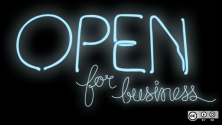For the last two years, we had only lightning talks and workshops at the ownCloud Contributor Conference. As chair of the paper committee at Akademy, I introduced a single morning track of lightning talks that turned out to be an exceptionally good model for creation-type events like ours. Your event might benefit from lightning talks too—here's why and how to plan them.
Why
To find the best way of presenting content to visitors you must define goals for an event. If your event focuses on creating collaboratively with people from all over the world, a track of lightning talks is a great way to kick off.
What
Lightning talks are very short sessions (3-15 minutes, usually about 5 minutes) that are typically scheduled in a single track. This means that the entire audience of an event is in the room and explains why the talks have to be short. Even if some of the subjects aren't interesting to everybody, the next one comes just a few minutes later.
These talks provide an opportunity for people to present what they work on and for the audience to find out what is going happening in the project. Perhaps more importantly, the audience can find out who to talk to—connecting names and faces to subjects.
Due to their nature, lightning talks do not go very deep. This is as much a strength as it is a weakness, though, as presenters are forced to get rid of most of the content so they focus on what matters most. Overhead like lengthy personal introductions, many examples or the setup of demos falls to the wayside and a single point emerges.

Photo by Jos Poortvliet, CC BY-SA 4.0
How
As the format is a little more unforgiving than 30 or 60-minute "tech talks," it's a good idea to practice in advance. Luckily, the short duration means that rehearsing the talk five or six times isn't a big time drain.
For the organization of an event, it is important to get the slides from the participants well in advance. This not only forces the participants to be prepared, but as there is no time to even switch presentation files, you can prepare them in a single go. I personally demand slides in PDF and concatenate them in a single file.
To keep the audience hooked, schedule the lightning talks with much variation. Alternate between technical subjects with process-oriented talks and social ones. Look for a light note occasionally, and be sure not to push too many down the throat of the visitors without an occasional break. During a break, people can look up the presenters and dig a little deeper, process the inspiration, and relate it to their own interests.
It also makes sense to have the lightning talks in the morning and/or the first day so they can provide a starting point, especially for new participants. They can set the tone—perhaps not like a keynote does, but in a more practical way.
If you additionally need more in-depth sessions and technical talks, you can schedule them in parallel after the lightning talks. This also gives speakers in the lightning talks the opportunity to invite people to these sessions, giving participants some insight in what they will cover.
An example
Based on my experiences in the last years, I would go with a daily schedule like this:
- Opening with a keynote (~30-45 minutes)
- 45 minutes of lightning talks (schedule about 7-8 of them)
- A 30-minute break (so people can discuss the talks)
- 1 hour of lightning talks (about 10)
- Lunch break (plenty of time to talk!)
- Afternoon program of workshops/technical talks/etc., perhaps kicked off by a 2nd keynote.
Of course, depending on when you start and stop and how many talks you have, you might want to add an extra hour of lighting talks. But be sure to follow them up with a break!
My personal to-do for the next #ownCloudConf includes practicing all lightning talks with all speakers in a one-on-one video call, both to solidify the deadline and increase quality.
Month
A collection of articles highlighting first-time Opensource.com contributors.







1 Comment